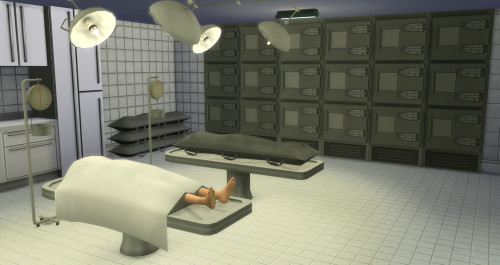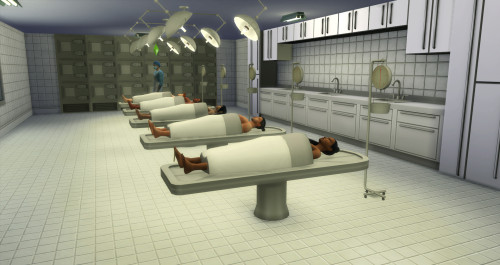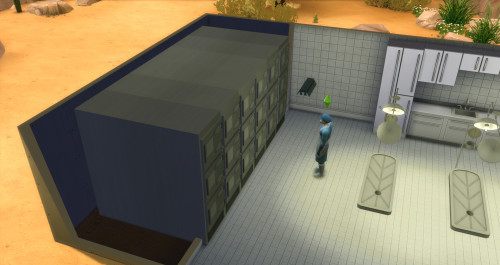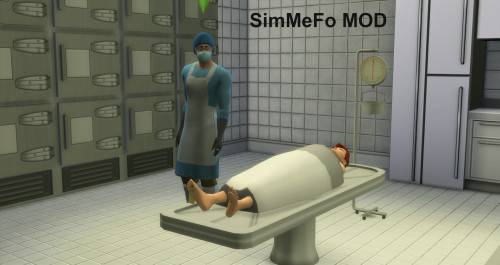#forensics
SimMeFo MOD (Sims Medical Forensics)
Hello. I have finished this 1st version of a CSI related MOD. With this MOD your sims can autopsy bodies. Tag them in the included functional morgue chamber and weight organs in the included morgue scale. In a future there will be more improvements. The mod includes bodies props a deco morgue chamber poster, the functional morgue chamber, functional slabs, functional morgue scale, surgery lights. Also I have included forensic clothing for your coroners as glasses, facemask, boots, and surgery hat. As a bonus I have created a morgue park with the morgue items.
Here it is a video in action.
Download Early access for patrons.
https://www.patreon.com/posts/49634967
This post will become public on 14- April-2021
Post link
Publication Date: February 9th, 2021
Rating: ★★★★★
As far as studying psychopaths, serial killers, and how they might have become the way they are, this book is an absolute gem. I knew when I started this that it was going to be a five star rating within the first few pages. Starting off with the preface, which was amazingly written and enticing the reader to continue reading, we read about the last “celebrity” serial killer of the epidemic years and a name everyone knows: Jeffrey Dahmer. Enough of a blurb to show how lives can change forever in one day and really kickstart the whole book.
Vronsky writes an absolutely fascinating introduction to the “golden years” of serial killers. His writing is clear and concise, and absolutely filled with interesting statistics, facts, and information. Organized by decade based on the adaption of serial killers in the time and featuring prominent killers in the media, we also learn about outside influences each decade that could help cook up the perfect storm that makes psychopaths commit these heinous acts. Things like wars and fathers with PTSD, media such as movies and magazine filled with dark themes in post war times, the politics of race and underreporting of black victims, the brain of a psychopath and the damage that can cause a shift in personality, etc.
One of the greatest parts of this book for me had to be Vronsky’s thorough use of his research and citations. I took down so many of his citations for science journals and books that I want to read to do further research. He remains seemingly objective to everything and merely writes things as they are, which is a talent to be respected when dealing with atrocities that break your heart. He is such a good writer that some of the descriptions and reading about the lives of the victims is devastating.
Thank you to Peter Vronsky, Berkley, and NetGalley for the opportunity to read this ARC, especially for such a well-written book.
-
Saylor Rains
Find me and this review on Goodreads.
Paul John Knowles (April 17, 1946 – December 18, 1974, death by a gunshot wound). Knowles was an American serial killer tied to the deaths of 20 people in 1974. Knowles claimed to have taken 35 lives.
The Casanova Killer’s (other names: Lester Daryl Gates. Daryl Golden) crimes span from July 26, 1974, to November 16, 1974.
Click For Image: HERE
Knowles was always in the eye of the law and was incarcerated at the age of 19. Knowles spent some time in prison, later he was arrested again after stabbing a bartender during a fight. Knowles being handy with locks picked a lock in his detention cell and escaped on July 26, 1974.
On the night of his escape in Jacksonville, Florida, Knowles’ cross-country murder spree started, his victim a 65-year-old woman. Knowles ransacked her home for money, valuables, and stole her car. Knowles went on to kill in the following states: Florida, Ohio, Nevada, Texas, Alabama, Virginia, Georgia. The youngest victim known was 7 years old.
Knowles was apprehended on November 17, 1974.
“Knowles grabbed Sheriff Earl Lee’s handgun, discharging it through the holster in the process and while Lee was struggling with Knowles and attempting to keep control of the vehicle, Angel fired three shots into Knowles’ chest, killing him instantly”
I am setting up an internship to learn hands-on the technique of forensic facial reconstruction. The person teaching me works with the American Museum of Natural History (AMNH) here, in NYC.
The technique (anatomical method) is said to be more accurate than the tissue depth markers (alone), and computer. The anatomical or morphoscopic method for facial reconstruction involves rebuilding the face, muscle by muscle, tissue by tissue. This method is attributed to a Russian anthropologist, Mikhail M. Gerasimov (1907 - 1970), and it was the first technique developed in forensic sculpture. Gerasimov studied the face of more than 200 people and other human ancestors (Neanderthal and Java Man, 1927).

Image Source: Ullrich, Herbert & Stephan, Carl. (2016). Mikhail Mikhaylovich Gerasimov’s Authentic Approach to Plastic Facial Reconstruction. Anthropologie (Czech Republic). 54. 97-107.
The anatomical method is basically “fleshing out” the skull, meaning that piece by piece, glands, cartilage, and muscles are sculpted. The skull provides information “written” on the surface of the bone, whether it be muscle origin(s)/insertion points, as well as areas of smoothness where cartilage sits, or depressions where muscles lay. All of this combined with anatomy allows a face to be reconstructed from a skull, this then provides an identity for human remains.
Gerasimov, in the 1930s, realized that he was able to reconstruct faces of racial types (ancestries). Between 1937 - 1939, Gerasimov reconstructed the faces of a Papuan, Kazakh, and Khevsur Caucasian. Gerasimov also performed many forensic reconstructions for the NKVD. When Gerasimov reconstructed the faces of Yaroslav I the Wise (1938) and Andrei Bogolyubsky (1939) he received public attention. During WW2, Gerasimov worked at a hospital in Tashkent, and the various deceased victims worked as test subjects for statistical data on human skulls.

Image Source: Ullrich, Herbert & Stephan, Carl. (2016). Mikhail Mikhaylovich Gerasimov’s Authentic Approach to Plastic Facial Reconstruction. Anthropologie (Czech Republic). 54. 97-107.
Gerasimov honed his skills, and in 1950 received the USSR State Prize. Studying, and being interested in prehistoric animal bones as a child proved vital for Gerasimov’s craft. When the Soviet Ministry of Culture opened the tomb of Ivan the Terrible, Gerasimov reconstructed his face and received payment for his work. Gerasimov even traveled to Europe to find the skull of the poet, Schiller, within a mass grave. Gerasimov was not a man of politics and was always willing to help his friends.
Legacy: Gerasimov’s method of facial reconstruction spread all over the world. The anatomical method has been used to reconstruct the faces of pharaohs, and in the 1990s Russia used it to clarify the identities of the remains of the family of the last Tsar. You can see Gerasimov’s work at the State Historical Museum in Moscow, Anthropological Museum of Moscow State University, Museum of Georgia, and Museum of Uzbekistan.
Gel Electrophoresis
Here is a photograph of my current classmates and I DNA before undergoing gel electrophoresis.
The DNA was loaded into the wells (tiny rectangles) with pipettes. When the gel is electrically charged, the DNA travels from the negative terminal (the black circle at the top left) toward the positively charged anode (where the red circle is at the bottom right corner).

(Note: The three wells (green rectangles) of darkest color on the second row are mine, my DNA is on the first two, the last and third well has extra water. It is my negative response well, to test that there is no contamination. If there is any contamination it will be observed in that third well.)
Contamination refers to DNA of other things (animals, plants, etc) showing up instead of the intended DNA for which results are being analyzed.
Here is the after photo. The DNA being viewed (since it was stained) under a UV light.
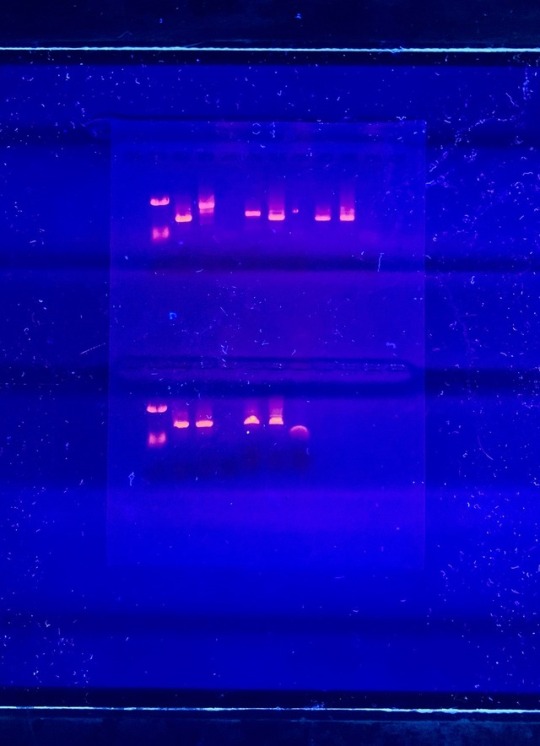
(Note: Another classmate added samples in after the first photo was taken. My DNA is in the second well from the left on the second row, and my positive is to the right of that well. The blank well in the center of the second row is my negative, not much showed which means there was little to no contamination in my DNA sample).
The gel used is made of agarose, which is easy to cast, and has relatively fewer charged groups. The agarose gel is suitable for separating DNA (and macromolecules) by size as it is charged (with electricity) and it travels through the pores in the gel (See some of the wells on the second image look more elongated).
DNA fragments can easily be extracted from the gel, which is a suitable electrophoresis buffer.
What are the applications of gel electrophoresis?
- It can be used to estimate the size of DNA molecules.
- To analyze PCR products, such as molecular genetic diagnosis, or genetic fingerprinting.
- To separate restricted genomic DNA.
Forensic Friday: Sexual Dimorphism and Sexing

Image Source: Mike Peel. www.mikepeel.net. Yorkshire Museum - skeleton of a wealthy woman 1. Wikimedia Commons.
In 1901, during the construction of the York to Scarborough Railway Bridge, close to the River Ouse, workmen discovered a large stone coffin with a skeleton inside. The skeleton was found with many unusual, and expensive artifacts. This is a significant discovery from Roman York. Studying the skeleton revealed that it belonged to a woman.

Image Source: Mike Peel. www.mikepeel.net. Yorkshire Museum - skeleton of a wealthy woman 2. Wikimedia Commons.
Sexual Dimorphism in Humans:
On average, men are 8% larger than women.
Anatomical differences between men, and women can be easily seen in some soft tissue, however, this is limited in the skeleton. The human skeleton shows subtle morphological differences between the skull, dentition, pelvis, and long bones of men and women. On average, female skeletal elements are smaller, and less robust than males.
Some areas of skeletal differences amongst human males and females are:
- Note: variation, and these traits are basically nonexistent on pre-pubescent skeletal remains.
Skull: Mastoid processes, median nuchal line, supraorbital margin, supraorbital ridge, chin, and gonial angle of the mandible.
Dentition: Canines.
Pelvis: Greater sciatic notch, sub-pubic angle, sacrum, and pelvic cavity. Women have wider pelvises to allow for child birth.
LongBones: On average are longer, and have more pronounced muscle attachments in males.
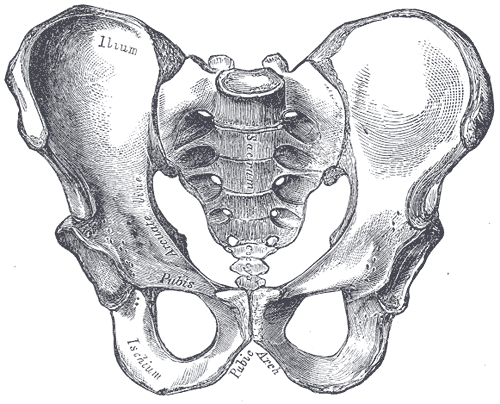

Image Source: Henry Vandyke Carter. Gray241. Wikimedia Commons.
Image Source: Henry Vandyke Carter. Gray242. Wikimedia Commons.
Left: Male pelvis. Right: Female pelvis.
How many carpals (wrist bones) are in one human wrist?
Can you name them all?
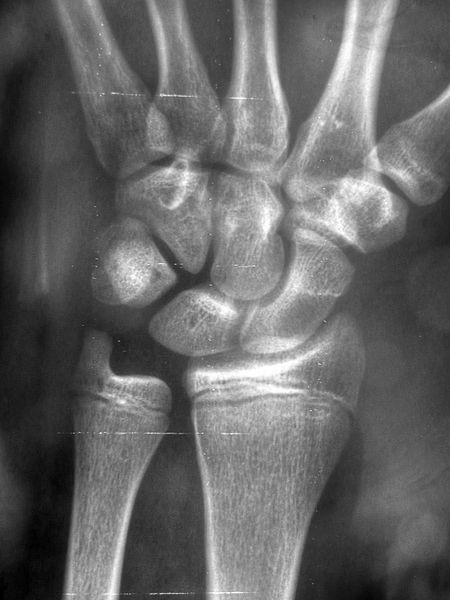
Image Source: Nevit Dilmen. Radiology 1300294. Wikimedia Commons.
Hint: “Some Lovers Try Positions That They Cannot Handle.”
Pop Quiz
Name the bone(s)?
What pathology do you notice at the shaft/diaphysis?
(Answers below)
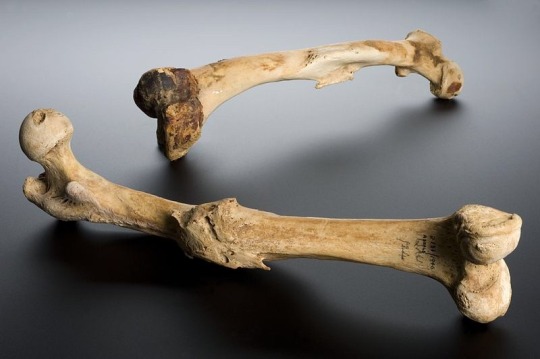
Image Source: Wellcome Images. Wellcome Trust. Human left femur, Tell Fara, Palestine, 100 BCE-200 CE Wellcome L0057387. Wikimedia Commons.
More information below:
“The femur bone is the bone joining the hip and knee joints. This femur shows an unreduced bone fracture. This means that the bones were not correctly realigned, using a splint or by surgical means, and therefore did not heal correctly. These femurs are from the left leg and the right leg of a human, although it is not clear if they are a pair. The bones were excavated at Tell Fara, Palestine, by the British School of Archaeology in Egypt, 1928-1929. The bones were purchased by Henry Wellcome from University College London the following year.”
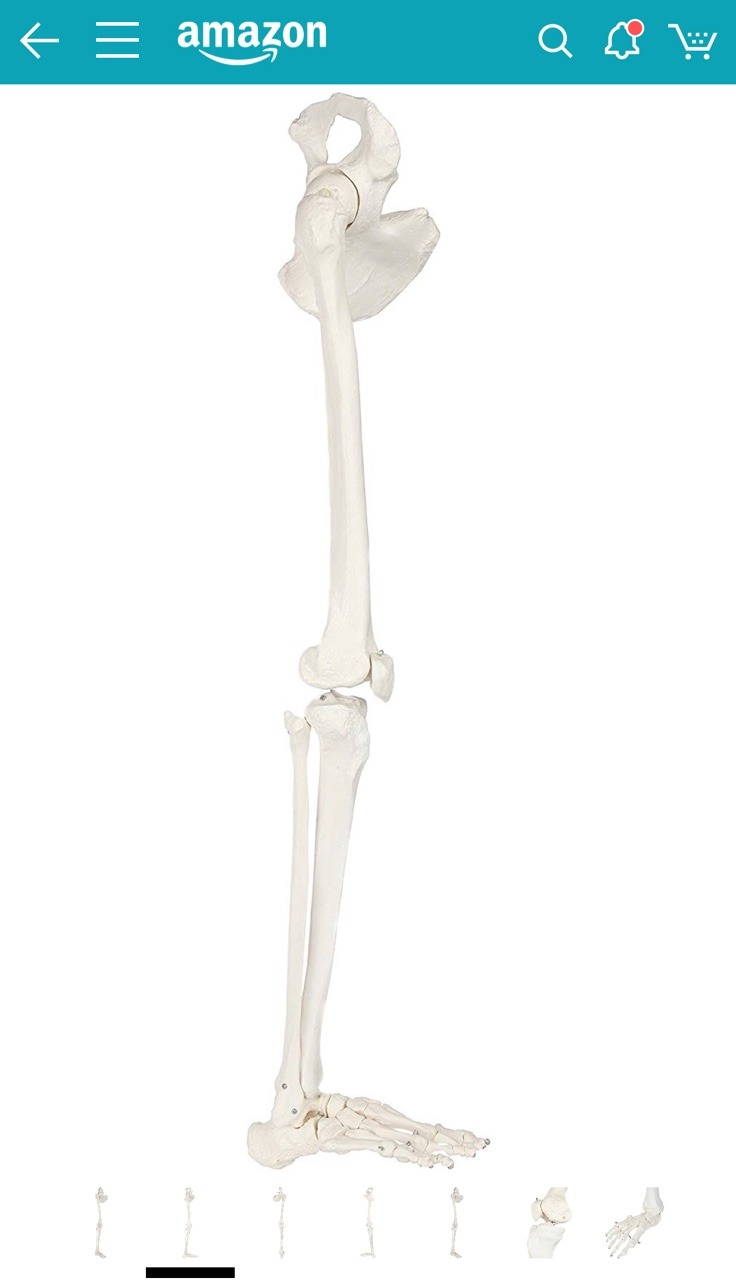
It is past 3AM, and I am browsing through Amazon when…
Who is Phineas P. Gage (1823 - 1860)?
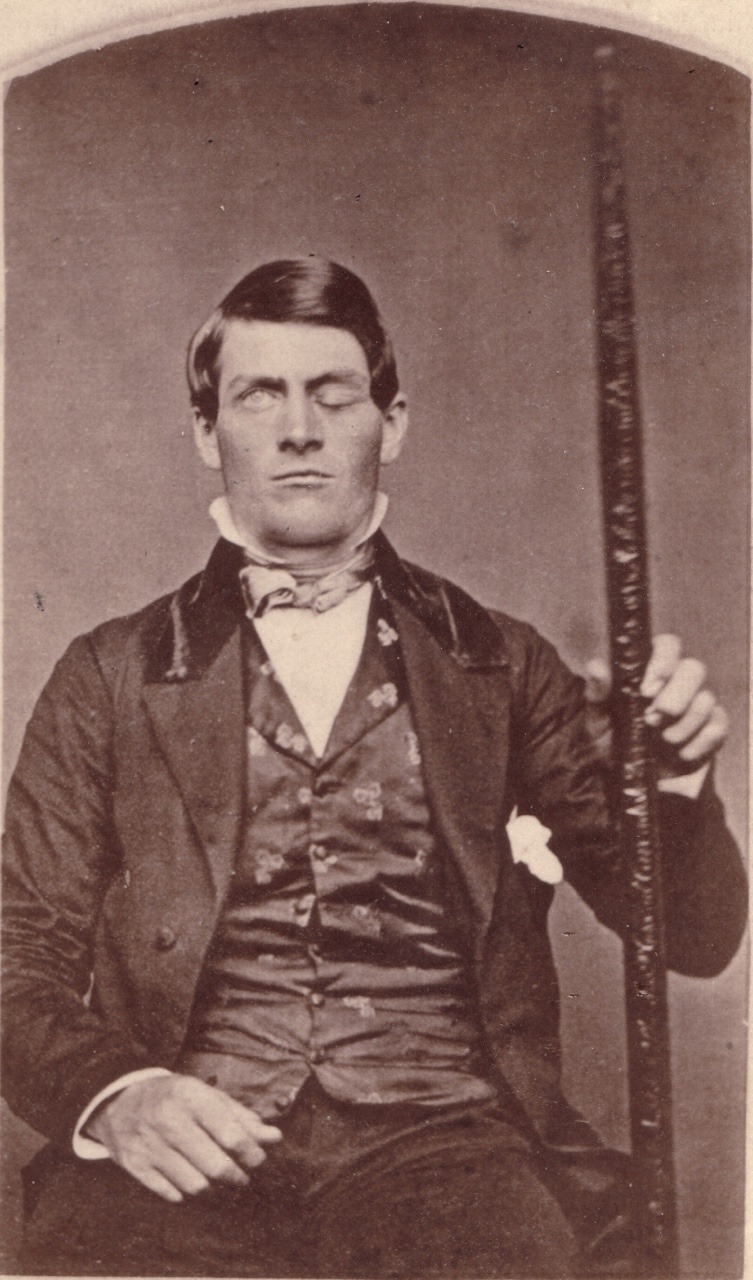
Image Source: Phineas Gage GageMillerPhoto2010-02-17 Unretouched Color Cropped. Public Domain. Wikimedia Commons.
Phineas P. Gage (1823–1860) was an American railroad construction foreman remembered for surviving an accident in which a large iron rod went completely through his skull. The iron rod destroyed a lot of Gage’s left side frontal lobe. After the injury, Gage lived for 12 years with effects on his personality, his friends described him as, “no longer Gage”.
The image below shows multiple views of the exhumed skull, and tamping iron, of Phineas Gage.

Image Source: J.B.S. Jackson, MD. JacksonJBS A descriptive catalogue of the Warren Anatomical Museum 1870 frontispiece 623x1024. A Descriptive Catalog of the Warren Anatomical Museum (1870). Wikimedia Commons.
Forensic Friday: Trepanation (or trepanning) is a surgical intervention in which a hole is drilled or scraped into the human cranium. The hole is made to expose the dura mater as a way to treat intracranial diseases, or to release pressure.

Image Source: Rama. Trepanated skull of a woman-P4140363-black. Wikimedia Commons.
Trepanation is one of the oldest surgical procedures with archaeological evidence.
Many prehistoric, and premodern patients had signs of bone healing, this means that many of these patients survived the surgery. Most of the crania with trepanation belong to adult males, but women and children also had the procedure done. In the New World, trepanation is commonly found among the Andean civilizations, and also in Mesoamerica.

Image Source: Wolfgang Sauber. Monte Albán - Trepanierter Schädel 2. Wikimedia Commons.
Tache Noir de la Sclerotique
(French for Black spot of the sclera)
Is a postmortem, reddish-brown discoloration seen in sclera of the eye.
This occurs when the eyes remain open after death. The sclera is exposed to air causing it to dry out, and change color.
For an image, click the link below.
Fig. 4 Tache noir of eyes resulting from post-mortem drying. Photo…
POP QUIZ:
Description of image: “Skull showing gunshot trauma Male profile, 1950s.”

Image Source: National Institutes of Health, Health & Human Services. Gunshot skull. Wikimedia Commons.
- Is this an exit, or an entrance wound? And why?
- Name the bone (or bones) affected by the gunshot trauma?
- Name two more bones observed in this image?
- What skeletal feature indicates this skull belongs to a male?
- Name one craniometric landmark observed in this image?
POP QUIZ!
How many bones do you see?
What joint is this?
Which side of the body are these bones from?

Image Source: Brian C. Goss. MedialHumerusRadiusUlnaArticulated. Wikimedia Commons.

Image Source: Sjbrown. Broken fixed arm. Wikimedia Commons.
Which two bones are fractured?

I am organizing for the coming academic semester, and I found a checklist/study guide from the last semester. Don’t forget to make studying fun! I’m a visual learner, and I use a lot of colors to make my notes more interesting to comprehend.
The Mayans developed great dental skills most likely for ritual, or religious purposes. It is believed that dental modifications were used to identify with a polity, ruler, region, or lineage. The Mayans placed carved stone inlays into prepared cavities on the front teeth. Minerals like jadeite, sepentine, pyrite, cinnabar, turquoise, hematite, and iron pyrites imbedded in these cavities can be observed in person at the Mexico City museum. To make the cavity on the enamel, the Mayans used a copper tube. The tube was spun between the hands, and powered quartz in water was incorporated as a means of making it abrasive. This action leads to the creation of a round hole on the tooth enamel. The stone inlays were grounded to fit exactly into the cavity. Younger children teeth have not been found with these modifications.

Image Source: Emmashavrick. Inlay dental modification. Wikimedia Commons.
Vocabulary: Latent Fingerprint
When deposits of oil and/or perspiration from a finger leaves a print on a surface it is known as a latent fingerprint. These fingerprints are not always visible to the naked eye, thus requiring a dusting technique with fine powders to make it visible. Once the power is on the oil/perspiration, it can be lifted with transparent tape for analyzing, protecting, and storing. Another technique for revealing latent fingerprints is to shine a laser at it, the laser will make the print(s) glow allowing for photographs to be taken.
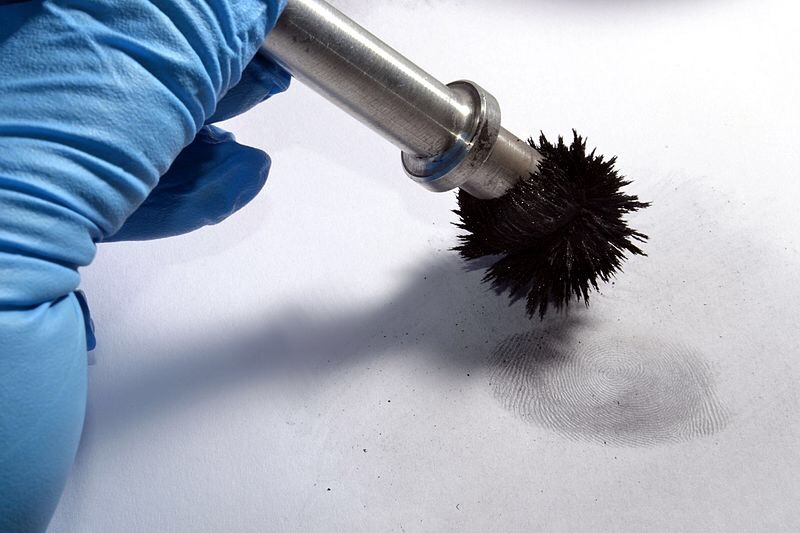
Image Source: Daekow. Fingerprint-magnabrush. Wikimedia Commons.
Aluminium is the most common powder used to develop latent fingerprints. A magna brush is a great tool for applying magnetic-sensitive powders over a hard surface. The aluminium adheres to the residue left behind by the oil/perspiration of a finger/hand, and reveals the print(s).

Image Source: National Institute of Standards and Technology (NIST). Latent Fingerprints (6774265822). Wikimedia Commons.
Fingerprints have been used for various purposes throughout human history. Thumb prints were used on clay seals in ancient China, and the ancient Babylonians used fingerprints on clay tablets for transactions.

Image Source: Mississippi Department of Archives and History. 6.13, 1963. Rifle that killed Medgar Evers. Located latent fingerprints on telescopic site. Medgar was shot off Delta Drive, Jackson, Miss. Wikimedia Commons.
Medgar Wiley Evers was an African American civil rights activist in Mississippi, and a World War Two veteran. On June 12, 1963, Medgar was assassinated by Byron De La Beckwith a member of the White Citizens’ Council, that was formed in Mississippi to resist the integration of schools, and civil rights activism. Medgar Wiley Evers was laid to rest with full military honors at Arlington National Cemetery. In the 1960s, the all-white juries failed to reach verdicts for the first two trials of Beckwith causing civil rights protests over the murder of Evers, and its trials. In 1994, new evidence in a new state trial led to Beckwith’s conviction
What is an osteosarcoma?
Who: Young woman, early 20s.
What: A malignant tumor of bone that has a rapid increase in osteoblasts (bone forming cells). The tumor measures at 24x23x19 centimeters, and was examined using x-rays, CT, and epi-illumination microscopy. The five pound tumor appears to not have affected the young woman’s food intake. The mandible is a rare location for such a tumor to develop.
When: 17th Century, unearthed in 1963.
Where: Buffalo, West Virginia, USA.
Osteosarcoma is the most common type of bone cancer, it mainly affects teens and young adults. For images about the case, take a look at the article below.
News Source: Basketball-Sized Jaw Tumor Found On Skeleton Of 17th Century Woman In West Virginia
Basketball-Sized Jaw Tumor Found On Skeleton Of 17th Century Woman In West Virginia

Image Source: Frank E. Beddard. The Cambridge Natural History, Volume X, Mammalia. Wikimedia Commons.
Here is a drawing of a human atlas, also known as the first cervical vertebrae C1. The image above depicts a young/not fully fused atlas, this is shown by the development of the anterior arch of the vertebral foramen (ia) not yet fusing to the anterior portion near the articular surface of the occipital condyles (as). Other notable landmarks include; the transverse process (t)— the transfers foramen directly medial to it, and the groove where the first spinal nerve and vertebral artery go through (g). The atlas has no vertebral body, no articular discs on its superior or inferior, and lacks a spinous process. On the posterior and medial surface of ia is the articulation for the dens of the C2.
Below is a fully fused C1/Atlas.

Image Source: Gliu. Atlante, prima vertebra cervicale, vista superiore. Wikimedia Commons.

